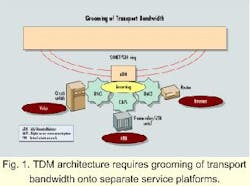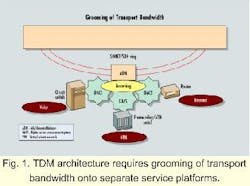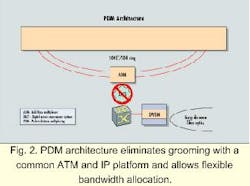Packet-division multiplexing for high-speed optical networks
A sweeping set of changes is overtaking service providers, enabling and even forcing radical changes in optical-network architectures. Driven by the explosion of the Internet and fueled by new technological breakthroughs, wide-area networking is being reinvented from top to bottom. New optical fiber is being deployed across North America and around the world, much of it by new entrants to the communications business. These new fiber networks will blend refined and recently invented technologies that are sweeping away the existing telephony-derived optical-network models. In their place, carriers are building data-focused infrastructures that will deliver massive bandwidth, reduced operational and ultimately consumer costs, and increased flexibility, while delivering telephony-class reliability to data networking for the first time. New entrants must leverage these advances to recoup their startup deployment expenses, while incumbent carriers must follow suit to avoid being placed at a competitive disadvantage.
Thus, service-provider network engineers must decide now which technologies will survive in the marketplace to design a service-enabling and cost-competitive network architecture. These network engineers are faced with a series of questions: What protocols will run in the upper layers of the new optical networks? Is Synchronous Optical Network (SONET) dead or will it live on, perhaps with reduced functionality? What are the role and the strengths and weaknesses of wavelength-division multiplexing (WDM)? How will reliability be engineered into the new networks?
Put simply, what is the new network architecture, and what are the challenges that face it?
Legacy wide area networks (WANs) are designed for voice telephony with data services layered on only after the networks were constructed. The network architecture, based on time-division multiplexing (TDM), offers a rigid division of long-distance bandwidth among the services that the network delivers within what is called the "transport layer." Typical services include voice, X.25, switched multimegabit data services, frame relay, Asynchronous Transfer Mode (ATM), and Internet protocol (IP). Bandwidth allocations are based on a strict hierarchy, in increments designed for voice telephony, enforced at the transport layer. Transport traffic is then "groomed" onto the service platforms-that is, voice traffic is separated and connected to voice switches, private-line traffic to frame-relay switches, and so forth (see Fig. 1).
Such cumbersome traffic grooming is now giving way to a new architecture that deploys IP and ATM in both the transport and service protocol roles. In this architecture, service provisioning is much faster, and the infrastructure costs are reduced by combining the separate transport and service layers, thus simplifying their installation and configuration. These new ATM-switching and IP-routing technologies build a high-capacity packet-division multiplexing (PDM) infrastructure in the last five miles between the end customer and the entrance point of a long-distance fiber network in a metropolitan area.
The PDM architecture represents a dramatic rethinking of the role of ATM and IP protocols that enable ATM and IP to deliver both the transport capacity and the required service (see Fig. 2). The traditional practice of constructing separate parallel service networks with separate switching platforms fed by a common TDM-based transport infrastructure is replaced with a bandwidth-intensive and cost-effective WAN architecture consisting of gigabit IP and ATM platforms directly connected to WDM transport equipment.
A PDM infrastructure allows ATM and IP to be deployed interchangeably. New vendor platforms for PDM networks thus enable carriers to configure physical ports to the required service type-ATM or IP. Why both? ATM is an excellent technology for integrating legacy traffic; it has a comprehensive set of adaptation layers (AAL1 through AAL5) that convert existing traffic streams into an ATM cell format in a standards-based, multivendor, interoperable method. Customers will continue to require ATM-enabled services, as the cost and timeframe to convert all of their applications to IP are prohibitive.
IP, on the other hand, delivers native-data performance for new applications and systems without the 10% bandwidth penalty caused by the 5-byte header on the front of every 53-byte ATM cell-the ATM "cell tax." New IP telephony developments suggest that even voice traffic may eventually migrate to the new PDM infra structure. IXC Communications, Frontier Globalcenter, Sprint, and Williams Communications Group, among others, are now deploying this IP and ATM WAN architecture.The key technologies enabling the new optical transport network are higher-speed optical connections with the ability to create more than one optical connection over a single optical fiber via WDM. As the number of wavelengths on a single fiber increases, WDM becomes dense WDM (DWDM). Systems capable of as many as 200 wavelengths on a single fiber have been announced. Each of these wavelengths carries data at 2.5 or 10 Gbits/sec, depending on the vendor, but in either case, more data can be transmitted down a single wavelength today than could be carried on most of the optical fibers in operation five years ago.
In the service layer, an important new development is the Multiprotocol Label Switching standard (MPLS)-a lightweight circuit-style overlay on IP that allows provisioning label-switched paths (LSPs) between MPLS-capable devices. Initial deployments of MPLS are strongly focused on traffic engineering and efficient bandwidth usage, but extensions have already been proposed for quality-of-service (QoS) guarantees, virtual private networks, and bandwidth protection. One benefit of MPLS-based services is the ability to operate over many kinds of network connections, not just new optical networks.
SONET and its European counterpart, Synchronous Digital Hierarchy (SDH), are the dominant transport technologies in existing networks. To provide commercial-quality services, the PDM architecture must replace each of the key features provided by SONET:
- service multiplexing and bandwidth allocation
- network reliability
- network architecture based on interoperable, multivendor standards.
Much of the work to address these areas is being conducted in two standards groups: the Internet Engineering Task Force (IETF) and the Optical Internetworking Forum (OIF).
The IETF (www.ietf.org) is a voluntary organization that sets standards for the Internet. Membership in the IETF is open to any interested individual. It holds three meetings a year, although much of the discussion and debate takes place on mailing lists devoted to more than 100 working groups. Optical-networking-related issues are being addressed in the Point-to-point Protocol Extensions Working Group and the Multiprotocol Label Switching Working Group.
The OIF (www.oiforum.com) was created to foster a multivendor optical-network interconnection, to increase the functionality of the optical network and increase service platform-to-optical network integration. The forum espouses the view that optical technology has advanced beyond single-wavelength optical transmission and that it is highly likely there will be an optical network that delivers increasing levels of functionality. With the acceptance of DWDM, technologies such as optical-fault restoration, optical routing, optical switching, and optical congestion management are logical increases in functionality that the OIF will pursue. Currently, the OIF's work is done in three technical working groups, focused on architecture, the physical layer, and operations, administration, maintenance, and provisioning (OAM&P).
The PDM architecture is designed around the concept of packet-based service multiplexing, which offers the prospect of much greater bandwidth efficiency than TDM, which is based on fairly rigid and large bandwidth increments. The PDM architecture allows more flexibility for devoting bandwidth to the services that need it at any given time, while ensuring that sufficient bandwidth is held in reserve to satisfy performance guarantees for critical services.
ATM has long provided clearly defined and enforceable bandwidth provisioning as well as QoS guarantees. The Internet, by contrast, has gotten by on best-effort delivery, with no performance or QoS warranty. MPLS enables Internet service providers to offer QoS guarantees. MPLS allows attaching a QoS description to each LSP provisioned through the network; each MPLS device must run a connection admission algorithm to guarantee-or reject-the requested QoS level.
To take full advantage of the PDM architecture, service providers will define several service levels (for example, bronze, silver, and gold), and also make a distinction between "elastic" and "nonelastic" traffic. Elastic traffic will carry the same value whenever it is delivered (within a few seconds) and may be subjected to queuing delays through the network. Electronic mail is an example of elastic traffic. Nonelastic traffic must be delivered promptly or else thrown away; voice and videoconferencing are examples of nonelastic traffic.SONET reliability is built on a circuit-protection mechanism known as automatic protection switching (APS). In APS, a "protect" fiber is defined for one or more "working" fibers. If a working fiber is disrupted-for example, by a backhoe accidentally severing the fiber-then traffic is automatically switched to the protect fiber. SONET also defines "ring" architectures, which use APS mechanisms and higher-level ring protocols to protect connections among a group of devices. Ring protocols are implemented by devices called add/drop multiplexers (ADMs). Essentially, the SONET connections are arranged in a circle between the ADMs so that there are two paths between any pair. If there is a fiber cut anywhere in the ring, traffic can be routed along another path to reach its destination.
SONET rings can span metropolitan areas or even be run across multiple states and provide some of the key reliability mechanisms underlying the existing telephony networks. This reliability comes at a significant cost, however: APS essentially requires that one-half of the network's bandwidth be reserved for failure recovery, and ADMs are very expensive devices.
PDM reliability covers a broad range, from APS-inspired implementations to less-expensive approaches that use protection bandwidth to carry lower-priority traffic as long as no faults have occurred. For example, MPLS-capable devices can provision backup LSP paths for high-priority traffic and implement 50-msec switchover in the event of a failure. Bandwidth on the backup path is used for lower-priority traffic while the primary path is operating, increasing bandwidth efficiency. Selection of the most appropriate approach depends on a service provider's required reliability level. Some simple rules apply to all cases, however:
- Service-level reliability approaches such as ATM or IP rerouting cannot substitute for native optical-network implementations in any high-availability network.
- SONET APS and ring architectures are a viable transition approach, until native optical standards are defined.
- To avoid expensive duplicate rerouting (or even oscillation), it is vital that failure-recovery mechanisms at multiple layers not react to the same failure.
Optical networking's greatest challenge may be interoperability, despite the efforts of the standards bodies. A new generation of equipment vendors must simultaneously push the technical envelope, mature their products for deployment, and define and implement new interoperability standards. These standards will propound a new reference architecture for optical networking and the APIs between the components of that architecture, as well as the fundamental standards such as optical wavelengths to be used.
As the new networks reach around the globe, successful vendors must be backed by a global service infrastructure to support optical-networking deployments in every corner of the world. Single-vendor networks may be a viable tactic for initial deployments, especially from established vendors with leading-edge products. Over time, however, service providers will demand and enforce rigorous interoperability as a precondition to deployment.
To control capital and operational costs, service providers deploying new optical networks are moving away from the higher-level SONET functionality. ADMs are too expensive to deploy, and TDM-style grooming is too expensive to administer in new multigigabit optical networks. As we have seen, pure optical replacements for SONET functionality are under development. There have even been proposals to do away with SONET altogether and use some new low-level framing approach instead.
Various organizations have suggested replacing SONET framing with a Gigabit Ethernet-derived approach, a lightweight "SONET-Lite" approach, or new protocols such as a Simple Data Layer. Any of these proposals, however, would have a major impact not only on the optical-network gear, but also on service platforms-the IP and ATM switch/routers that must connect to the optical network. Any approach that would replace SONET must show a major increase in reliability or manageability, or an equivalent decrease in cost, to justify the new development costs. Thus far, these benefits have not been demonstrated, and it seems likely that SONET will continue to play a role as the low-level framing approach and common interconnection layer for the new optical transport layer.
The challenges to optical networking may seem formidable, but the motivation to solve them is equal to the task. The payback will be new globe-spanning PDM networks that operate at speeds undreamed of a few short years ago, and with a much more efficient mating of bandwidth to services. Lowered capital and operational costs will translate into lower cost to users and new services that will revolutionize the face of telecommunications, just as optical-networking technologies have revolutionized its foundation. u
David H. Kaufman is director of product marketing at Argon Networks (Littleton, MA), a Unisphere Solutions company.


